Qustodio Review: Is Its Premium Features Worth the Price?
Qustodio Overview
Although there are cheaper options, Qustodio is one of the most popular parental control apps on the market. I often see seasonal discounts that reduce the price but are the parental control features that much better than other cheaper apps? I downloaded Qustodio and performed thorough tests to see what it’s all about and whether or not the price was justified.
Moreover, I decided to put this restriction to the test by challenging my 16-year-old son to find ways to circumvent it, with the goal of identifying any potential weaknesses that could be exploited. Furthermore, I conducted a comprehensive examination of the company, meticulously reviewing their Privacy Policy to ensure the highest level of security and to verify that my children’s data would not be at risk of compromise or sale.
My conclusion: Qustodio did a great job monitoring smartphones and computers and excelled in nearly every test I performed. It’s definitely worth the price – It is one of the most flexible and easy to use parental control apps I’ve ever tested and it comes with powerful security features that my kids were not able to bypass. You can test Qustodio for free with a 30-day free trial – no credit required, and make sure it’s the right app for your family.
⏳2024 Update! Qustodio has dropped prices for a limited time. Get 12% off an annual subscription when you use the coupon code WIZCASE12 at checkout! Be sure to grab it now before it’s gone.
Protect Your Child with Qustodio
Don’t Have Time? Here’s a Short Summary (1-Minute Read)
- Powerful Web Filter: The customizable web filter has over 30 categories that you can “Allow,” “Alert Me,” or “Block.” You can add specific URLs to be a block or allow list. Jump to Web Filter feature.
- Comprehensive Screen Time Management Tools: Create a calendar that limits or restricts the child’s phone throughout the day and evening, and add a daily screen time limit. See the complete screen time features rundown here.
- YouTube Monitoring: Check out your child’s YouTube search and viewing history, and set rules for using the YouTube app and website. See how to set the rules here.
- Remote Control Access for Apps and Games: Set time limits or block apps on your child’s device from your dashboard. See how to manage your child’s apps here.
- Call and Message Monitoring: Get access to your child’s call history and SMS messages and block any contacts you don’t want interacting with your child. See how to activate this feature here.
- Live Location Tracking: Track your child’s movements with real-time location tracking and detailed location history. Get more details here.
- SOS Button: Your kid can send an SOS alert to the trusted contacts and request for help, with a live location update. Learn more about SOS button here.
- Detailed Reporting: Get up to the minute reports showing how long your child spends on the phone, frequent contacts, favorite website, app use, and more. Get complete details on the activity reporting here.
Features
Qustodio has all the features that I look for in a parental control app. It gives me the remote access I need to monitor what my kids are doing online, who they’re talking with, which apps they are using, and how much time they spend on their phones. I use that information to create healthy screen time schedules and filters to protect them from inappropriate websites and screen time addition. Here’s a quick summary of Qustodio’s features:
Qustodio Features – Updated in 2024
| ? Free Trial | 30 days – No credit card needed! |
| ? Best Price | $4.58 a month – works on up to 5 devices |
| ? Web Filter | 30+ categories |
| ? Screen Time Management | ✅ |
| ? Location Tracking | ✅ Live location and 30-day location history |
| ? Geofence | ✅ 200 meter radius |
| ? Call and SMS Monitoring | ✅ (Android and iPhone) |
| ⚙️ App Management | ✅ |
| ? SOS Button | ✅ |
| ? Customer Service | Live chat, schedule phone calls, FAQ |
| ? Platforms | PC, macOS, Android, iOS, Amazon, and Chromebook |
Comprehensive Web Filter with 30+ Categories
I had complete control over what types of websites my kids can visit with the Qustodio web filter that has over 30 customizable filters. I had the option to leave the default settings, which is pretty thorough, or go through each category and either allow access, alert me when my kid visits a site that fits the specific category, or block it.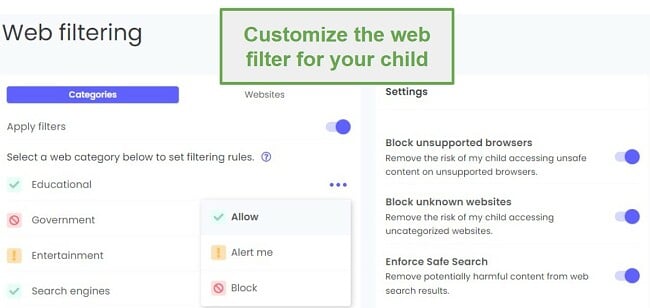
I asked one of my older children to find a way around the restrictions set by the web filter. The only method that worked was using a browser that Qustodio, the monitoring software, couldn’t track. I was pleased to discover that Qustodio was already aware of this workaround and offered an option to prevent unsupported browsers from being used through the web filter feature. Presently, Qustodio is compatible with Chrome, Firefox, Edge, Safari, and Amazon Silk. Therefore, when I noticed that my son was utilizing the Opera browser or the preinstalled browser on his phone, I activated the “Block Unsupported Browser” option in the dashboard. Consequently, he was unable to access the browser. Additionally, there are other settings in place to block websites that cannot be categorized and to enforce Safe Search on major search engines and YouTube.
In addition to blocking web categories, you can also manually enter URLs that should be blocked or allowed, regardless of their category. For example, while I blocked gambling sites, I didn’t mind my son playing fantasy sports. I unblocked the site he uses, and kept the Gambling filter on for casino and poker sites.
Prevent Screen Time Addiction with Daily Limits
With Qustodio, you can set a general time limit for how much time is allowed on the device per day. You can set different limits for each day of the week, allowing for more time on the weekend, for example. The daily time limit can be set in increments of 15 minutes. One thing that was very important to me, that I didn’t see in other parental control apps is that when the time limit was up on their phones, they could still make phone calls and access their contacts. As a parent I found this very helpful, knowing they could call me or my wife even when the rest of the phone is locked. Of course, if we’re all at home and I want them off the phone, Qustodio does have the option to block the Dialer and Contacts.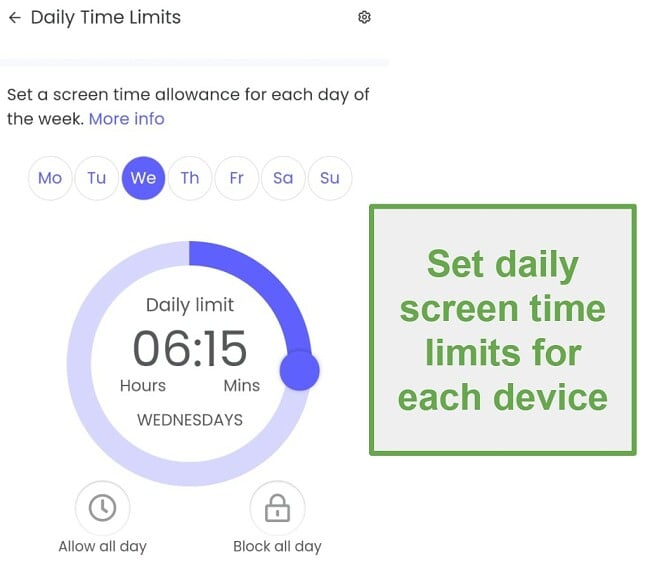
| Lock Navigation | Lock Device | |
| Android | Block all apps except the phone and contacts. | Only emergency calls and the Qustodio SOS button are available. |
| iOS | Blocks internet access. | Hides any app with a 4+ age rating and higher.* |
| PC and Mac | Prevents browsers from connecting to the internet. | Automatically logs out the user account, which blocks online and offline use. |
| Chromebook and Kindle | Block all apps except basic apps like calculator and calendar. | Locks the device. |
⚠️ [*] When the iPhone or iPad is unlocked, all of the apps will be rearranged and appear in alphabetical order, which can change how your child organizes their iPhone. If this will be a problem, it’s best to only use the Lock Navigation option for iOS.
Set a Daily Usage Schedule
This allows you to set specific times each day that the phones will remain locked. I found this to be more helpful than a general time limit, as I was able to make sure that the kids weren’t on their phone in bed or when they should be doing homework. My biggest concern with the restricted time features is that you can only allow or restrict times in hour-long chunks, beginning from the top of the hour. In other words, I can’t block the phone from 5:00 – 5:30 and then allow the kids to use it from 5:30 – 7:00.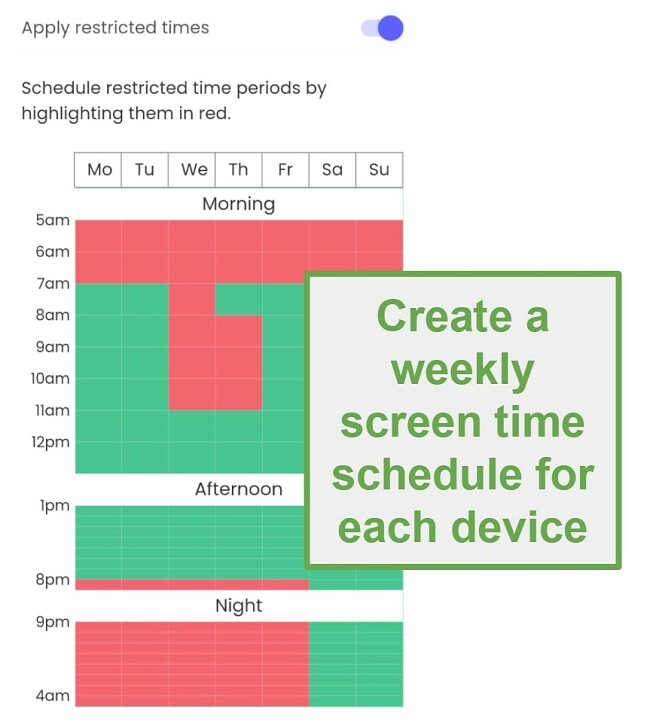
See What Your Kids are Doing on YouTube
While the YouTube monitoring feature won’t block videos, it will show you search and viewing history for each child. One feature I really liked that I didn’t see on most other parental control apps is that Qustodio can monitor and block both the YouTube app and browser. This is great because, with other parental control apps I tested, my kids quickly figured out that they could just go to YouTube through the browser and watch for as long as they want. However your kids get on YouTube, Qustodio’s monitoring will show you their search and viewing history.
- YouTube.com – Qustodio can block access to the site completely.
- YouTube App – You can block the app and set daily time limits for how long the kids can use the app.
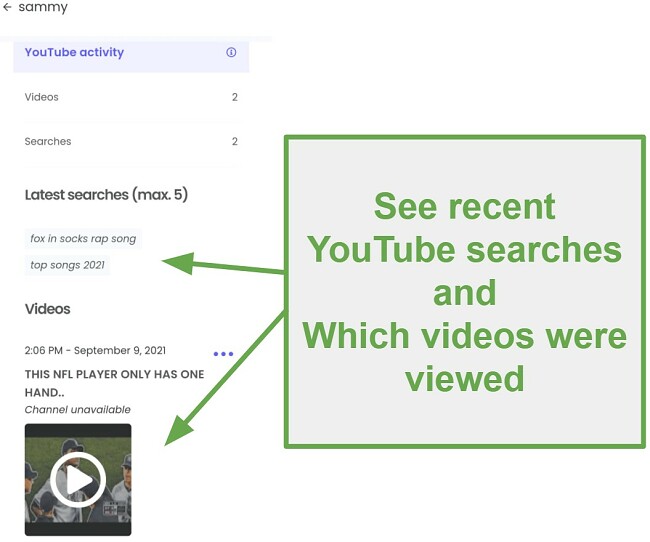
YouTube monitoring is available for Android, iOS, PC, and Mac. The monitoring capabilities vary slightly depending on which platform is being used:
| Android | iOS | PC and Mac |
| Lists the viewed videos and search history on the YouTube app. | Lists the viewed videos and search history on the YouTube website. | Displays detailed information, such as the YouTube channel and a video thumbnail, and the YouTube search history. |
It’s good to remember that you can block the YouTube website through the filter and the app in the Games and Apps section to ensure that you can monitor their YouTube activity.
While I wasn’t able to filter YouTube videos and block specific categories, I could enable Safe Search, which is YouTube’s internal filtering system. SafeSearch isn’t perfect, and I noticed that some videos slipped through, which I was able to see in the list of viewed videos.
Set Rules for Each App and Game
This is where you can set specific rules for each app on your kids’ devices. I find this to be the most helpful feature since my kids need some apps, such as WhatsApp, for school and youth groups, but I still want to restrict how much Netflix they watch.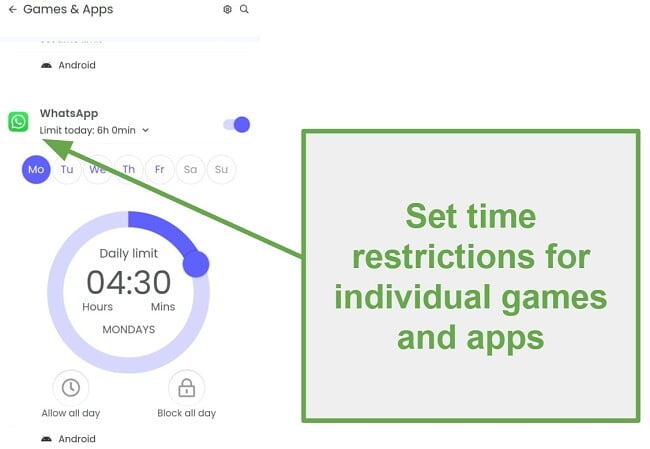
When I first installed Qustodio, I didn’t see any apps or games listed for me to block. However, after my son used an app, it appeared on the dashboard. This was helpful because I didn’t have to waste my time setting time limits or blocking apps that he wasn’t using. I also found it convenient to not have to scroll through a hundred apps to find the ones that I was looking for.
The Apps and Games feature is compatible with Android, PC, Kindle, Chromebook, and iOS. The fact that it works with iOS is impressive, as many of the parental control apps I’ve tested are not able to block or limit apps on iPhones and iPads.
The one limitation I found in this feature is that monitoring is limited to screen time limits and blocks. I couldn’t monitor messages or DMs that are sent and received from apps like WhatsApp, Messenger, Instagram, Snapchat, Telegram, or Twitch. If you need to read messages from these types of apps, check out Bark, which uploads messages that trigger its filters to the parental control dashboard.
Call & Messages Monitoring: See Who Texts and Calls your Kids
The Call & Messages monitoring feature made it easy for me to see who my children are talking to on the phone. While it doesn’t record the phone calls, I can see the incoming and outgoing call log, along with a timestamp and the length of the call. It gives me the option to block outgoing and incoming calls by opening the Rules section of the Dashboard and opening the Calls and Messages section. After clicking the Add A Number button, I can add any phone number and give the contact a name – and block incoming, outgoing, or both the contact name and number.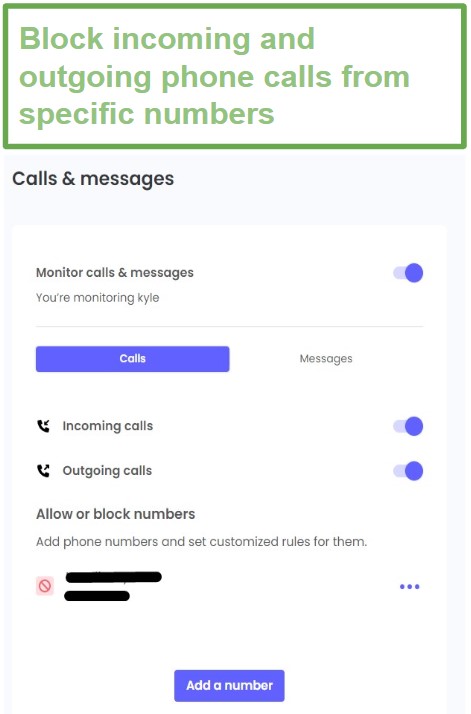
If the child attempts to call the blocked number, they will get a notification on their phone that the call is blocked. However, there is no notification when an incoming call is blocked. The caller gets a recorded message that the phone number they dialed was unavailable. However, I could see in my activity timeline that the call was blocked. The downside to this feature is that it can’t block VoIP calls or video calls from services like WhatsApp, Meet, or Zoom.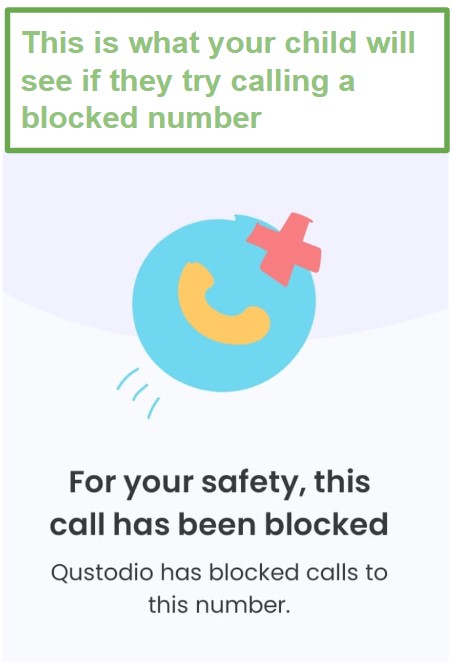
While Qustodio can’t view messages sent from third-party apps, it uploads all SMS messages to the dashboard, so I could read them. At first, I couldn’t figure out how to find these messages, the dashboard home screen only displayed the information about who sent the messages. It was only when I opened the Timeline that I was able to read the content of the messages.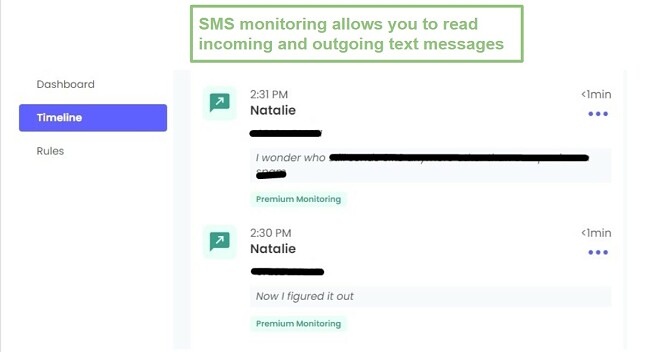
Unlike the phone call part of this feature, I couldn’t block specific contacts or phone numbers from sending my son SMS messages.
? Important: Call & Messages Monitoring feature is not included in the Qustodio app that you can download from Google Play. If you want access to this feature, you will need to download the app from the official Qustodio website.
Location Feature Will Track Your Kids in Real-Time
With the Qustodio GPS tracking, you won’t have to worry about where your kids are, as long as they have their phones with them. You can view their location, in real-time, on both the computer and mobile dashboard. Their avatars are superimposed on a map, so you’ll know if they’re really studying at their friend’s house, or if they’ve gone to some other location.
One of the biggest improvements in the updated Qustodio app is creating a geofence. It is known as ”My Places” on Qustodio and can only be set up through the parental mobile app.
You can set a location with a radius between 100 – 200 meters, and whenever your child enters or leaves the area, you’ll receive a notification. You can set the geofencing by tapping the “See Locations” link next to the location tracker in the timeline > Tap the location pin icon > Add A New Place. Now you can enter the address and a radius of up to 200 meters.
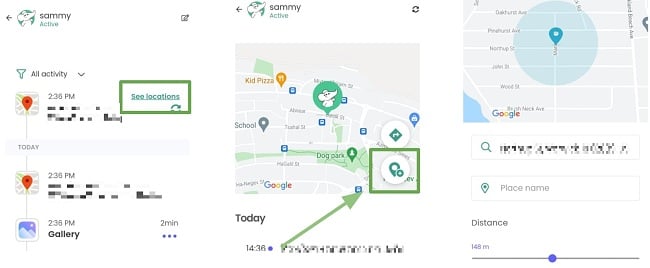
Call for Help with an SOS Button
In my original review of the Qustodio app, I was not very impressed with the SOS feature. It’s supposed to be a button that the child can press to send out an instant “Help Me” message, with GPS coordinates to a trusted contact. I thought it had a lot of promise, but it was too buggy and difficult to use. I’m very happy to report that with this latest update, the SOS feature is much improved.
Click the Settings gear on the button on the right corner on the mobile device and click Set Rules, or locate the SOS button on the left-hand menu on the browser-based dashboard to access the rules page. You can invite multiple “trusted contacts” that will be alerted whenever the SOS button is pressed. Each contact can have a phone number and email address, so they’ll see the alert right away.
The child can access the SOS button through the Qustodio app on their phone. On the bottom of the screen is an SOS button. Once they click it, it will open the SOS alert button. After they press the button, Qustodio will send an alert with the child’s current location to the listed email and phone numbers.
When the danger is over, the child will press the button again to end the alert, and the system will offer to send a message via SMS, Facebook Messenger, or Hangouts to let the trusted contacts know that everything is OK, and it will also include the child’s current location.
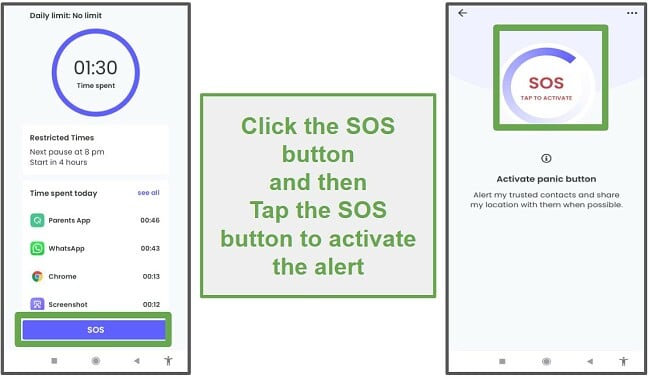
? Important: Qustodio will not contact the police or emergency services when your child presses the panic button. If you fear for your child’s health or safety when they send out an SOS, call your local police immediately and share your child’s live location information with them.
View Reports on the Parental Dashboard
As the parent account holder, I can view the dashboard on my smartphone or by logging into my Qustodio account on any browser. Both dashboards give a clear overview of what the kids are doing online and where they have been. After logging into my dashboard, I can choose which child activity to review. The first page I see is the Activity Summary. I can filter it to today (the previous 24 hours), 7 days, 15 days, or 30 days. There is also the option to view the data from any date over the previous month. The Activity Summary provides an overview of the following information:
Screen Time: Displays the combined screen time for all devices assigned to the child.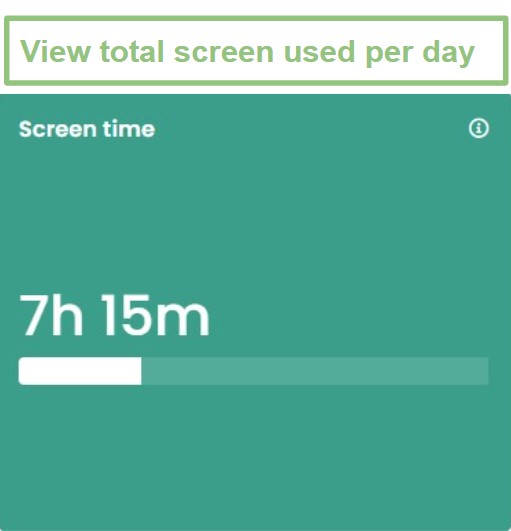
Screen Time Per Hour: Provides a graph showing when your child was on the device.
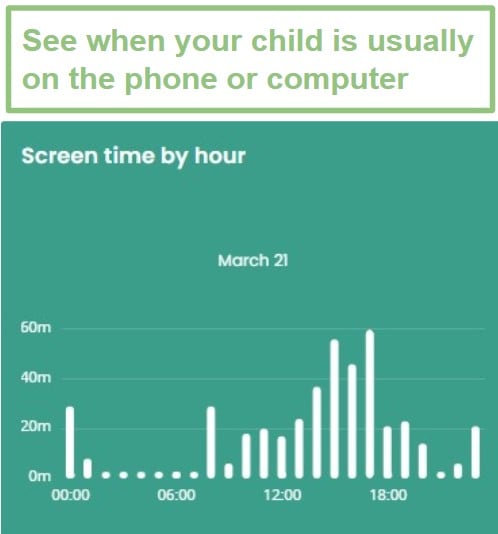
Blocked Websites: See which websites your child tried to access but was blocked because of the filter.
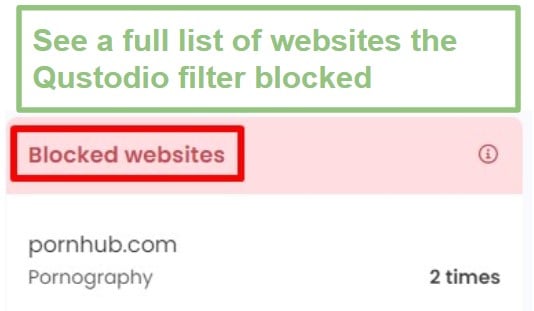
App and Web Activity: Lists the 5 most used apps and shows how much time your child spent using each app.
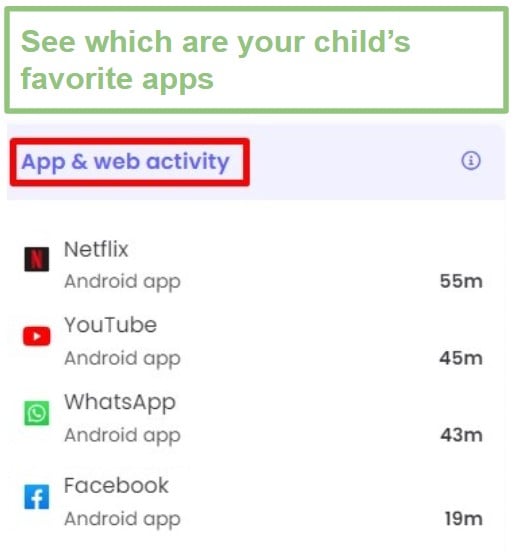
Web Searches: Tracks which words are used in Google and Bing searches. What makes this feature stand out is that instead of simply listing the entire search phrase, it isolates and tracks the main words from each search. This way, I can see exactly what kind of information my child is searching for without having to read through multiple search phrases and find the connection myself.
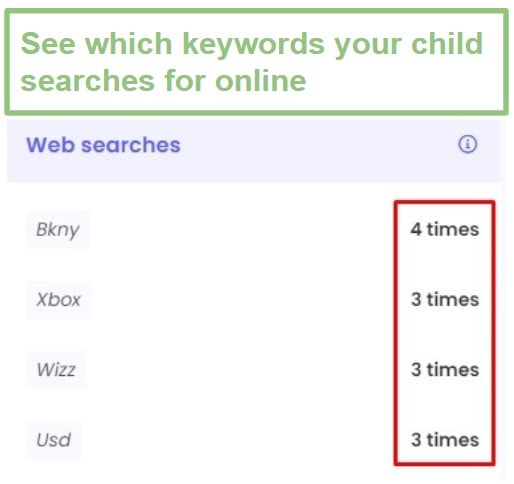
Call and Messages: I could see who my son was talking or SMSing with and how frequently they communicated. What this doesn’t show is incoming or outgoing calls that weren’t answered and the content of the SMS.
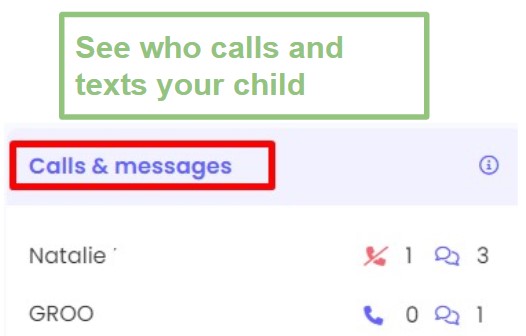
YouTube Activity: Shows the number of videos viewed, the number of searches, and the search terms. I clicked on the See Videos link at the bottom of this section to get more information on the viewed videos. It includes the video title, and a thumbnail that opened in YouTube when I clicked on it.
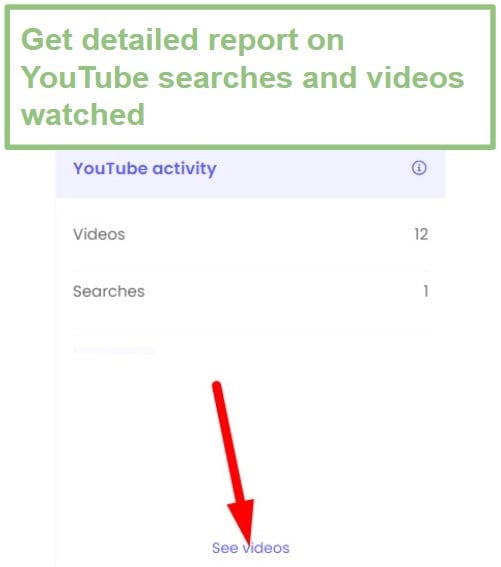
My only complaint with the Activity Summary is that it combines the data from all devices assigned to the child’s account. For example, I was monitoring my son’s phone and computer, but it was all displayed in one group. The only solution is to create a separate profile for each device if I want to see the difference between his computer and smartphone activities.
The Activity Summary is great because it gives a quick overview. If you want more than just the “Top 5” for each section, click on the See More link at the bottom, and Qustodio provides the complete list of activities for that section.
Use the Timeline for More In-Depth Monitoring
I use the Timeline for a detailed look at how my children use their phones, tablets, and computers throughout the day. It lists every action in chronological order, so I can get a good idea of how my kids are spending their screen time and see if there is anything to worry about. If I see that one of my kids is using an app I don’t like or spending too much time with a certain app, I can block it directly from the timeline. Unlike the Activity Summary, the timeline does show which device is being used for each action.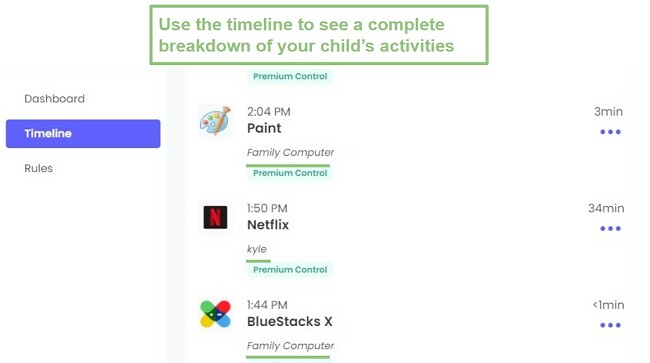
In addition to chronological order, the Timeline has a filter where you can view every action for the following categories: Web Activity, App Activity, Searches, Calls and Messages and Locations.
Installation
The Qustodio for Kids app can be installed on Android phones and tablets, iOS devices, Amazon Kindle, Chromebooks, PC, and Mac. There is also a Qustodio app for parents that can be installed on iOS and Android devices, or you can log in to your dashboard through any browser.
Before installing the app on your child’s device, you will need to register your account and create a user profile for each child. I created a user profile for my son, which just meant adding his name, birth year, and gender (there is the option for “prefer not to say”), and then I chose what kind of device I wanted to monitor.
Since my son has an Android, I’ll use that for this tutorial, but Qustodio gives great step-by-step installation instructions for all platforms.
Once the profile was ready, I received a download link, which meant I needed my son’s phone to install the app. I opened the link on his phone, which automatically redirected me to the Google Play Store. After downloading the app, I chose the “Protect This Device” option and logged into my account.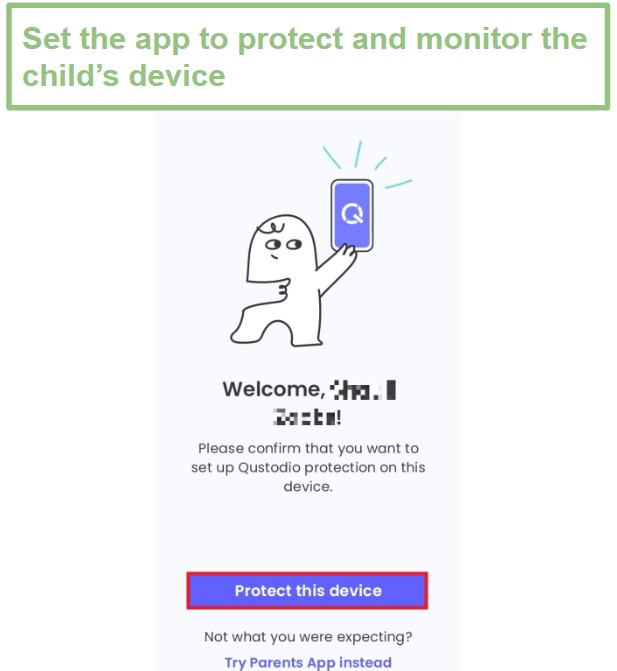
Qustodio has an easy-to-follow installation guide to ensure that all the permissions needed to monitor and enforce the parental control rules are activated. The first step is to name the device; this is how it will appear on the dashboard, so you want to choose a unique name. Then, I had to allow notification access, reporting, and usage tracking. These permissions allow Qustodio to track app and web use, create reports, and protect the device.
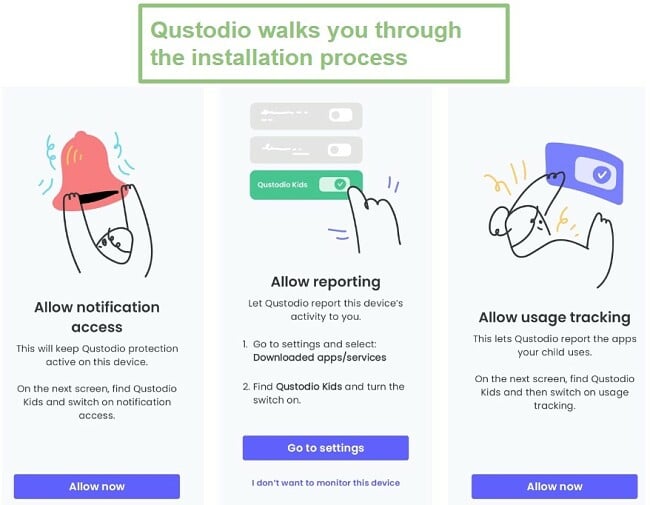
The next group of permissions is to Allow Permission, Access to the device GPS for location tracking, and letting Qustodio display over apps, which is needed for blocking apps or locking the device when the device reaches its screen time limit.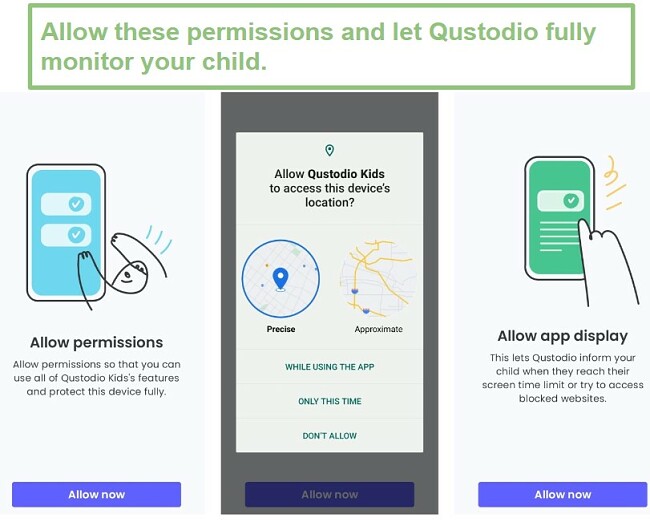
The last step is to Activate Device Admin. This is one of the methods used to prevent your child from uninstalling Qustodio. When I pressed the button, a warning page opened, and I had to wait 10 seconds to confirm this action. Once I pressed OK, the device was protected, and Qustodio immediately started monitoring it.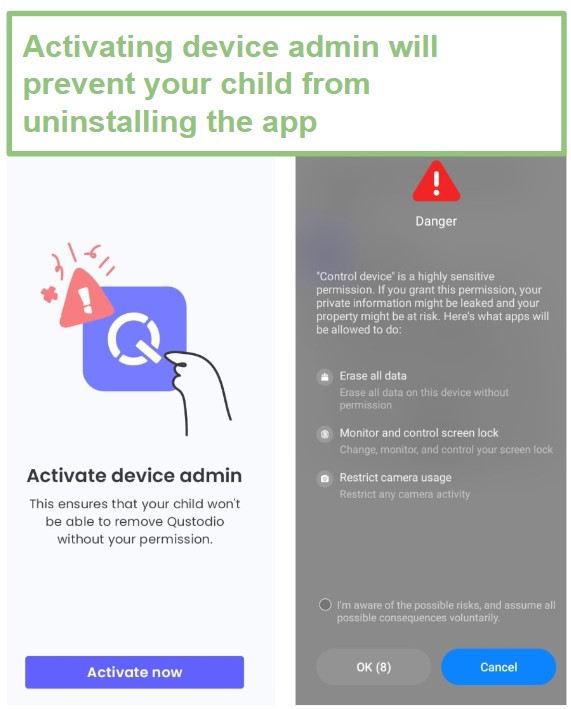
⚠️ Important! While the basic app is available for download in all the apps stores, if you want to use the Call & Messages feature, you will need to follow the instructions below.
Installing Qustodio with Calls and Messages Monitoring for Android
I don’t understand why Qustodio sent me to the Play Store to download the app, as this version of the app doesn’t have the Call and Messages feature. To download the full app, I needed to log in to my dashboard, open the Rules tab, and go to the Calls and Messages section. Then, I clicked on the “Instructions for Android” link, which opened a hidden page in the Qustodio help section.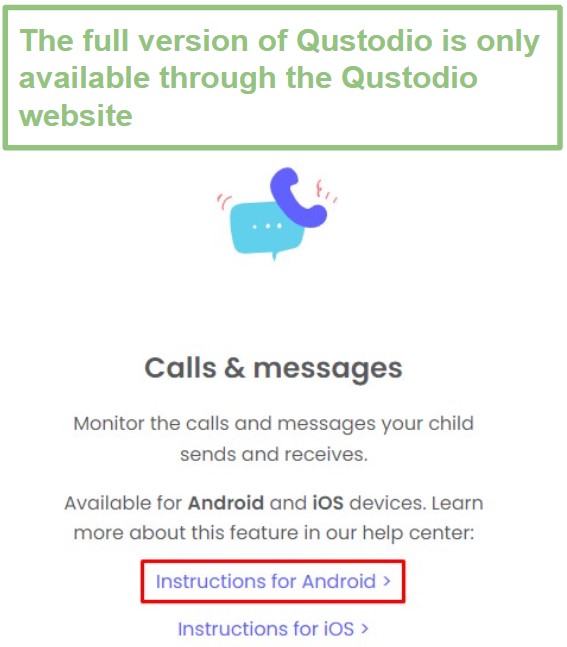
I pressed the Download button, and the APK file downloaded to my son’s phone. If you haven’t adjusted the settings to allow downloads from unknown sources, Qustodio will prompt you to do so. After the download is complete, open the app, and you’ll have to walk through the same steps listed above to properly install and set up Qustodio.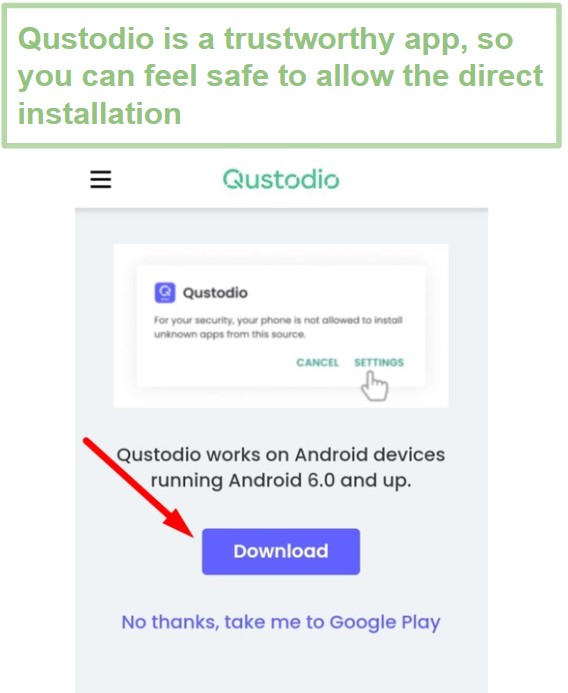
Installing Qustodio with Calls and Messages Monitoring for iOS
The Qustodio for Kids app in the App Store doesn’t have the Calls and Messages feature. However, unlike the Android app, you can’t directly install an app on an iPhone without jailbreaking the device. Instead, Qustodio has a different workaround, but you will need a Mac with Qustodio installed on it to activate the feature. This feature monitors calls, SMS, and iMessage.
Login to your parental dashboard from the Mac, open the Rules, and go to the Calls and Messages feature. Click on the Instruction for iOS link, and the hidden page in the Qustodio help section will open.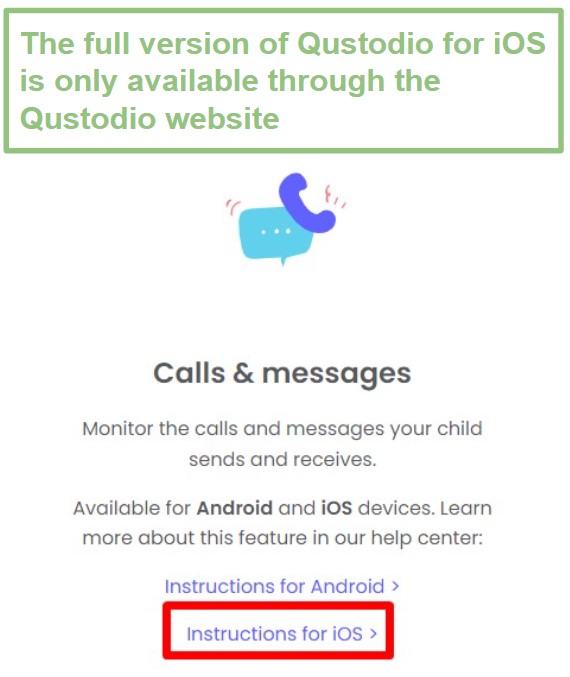
Press the Download button to install the Qustodio Calls & Messages app on the Mac. Then, using the iPhone cable, connect the iPhone to the Mac and leave it connected during the entire setup process as described below:
1️⃣ Login to your Qustodio account and press the Let’s Start button.
2️⃣ Using your child’s passcode, unlock their iPhone and press Trust on the pop-up window.
3️⃣ Press the Sync Now link. That’s it. This is the only time you will need to connect the two devices.
Once this process is complete, the iPhone will sync every hour with the app, as long as it’s running on your Mac, and both devices are on the same Wi-Fi network. You can also sync the devices on demand by opening the app on your Mac and pressing the Refresh button.
After I finished installing the app on my son’s phone, I downloaded the Parental app. This process was the same as downloading any app, and I didn’t need to give it any special permissions to work.
Ease of Use
Qustodio is very easy to use, even for parents who aren’t tech-savvy. Once the setup is complete, there is no need to access the child’s devices, as everything is managed from the parental dashboard, which can be downloaded as an app or accessed from any web browser. The main difference between the two is the Family Locator feature. The mobile app has a map that shows each child’s live location, while the browser dashboard only displays the location on the Timeline. Here’s a closer look at both options:
Qustodio for Parents App
The app has an intuitive interface, making it easy to find the features I need. The homepage is divided into three sections. On the top bar is a Quick Action button. Tap it to open the menu and pause the internet on all devices assigned to the child’s profile.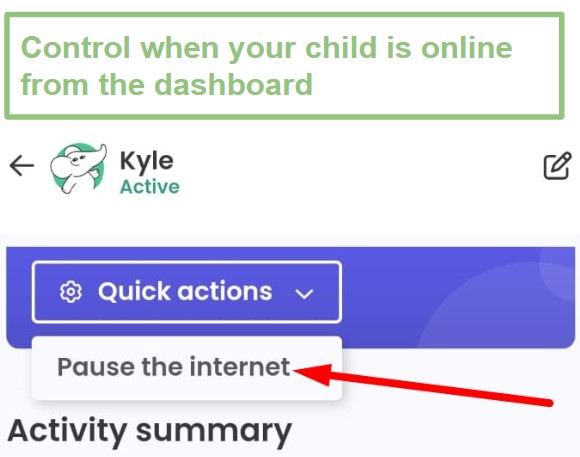
The Activity Summary is directly under the Quick Action. The screen time used information is displayed on top. Just swipe your screen from right to left to view the other activities.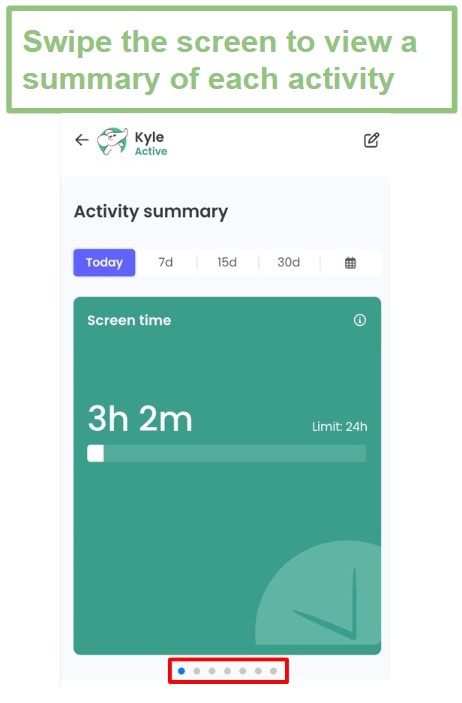
The timeline is just below the Activity Summary. You can scroll down or use the filter to find specific action items. To set the rules, click on the Settings icon on the bottom right corner of your screen. Then, press the Set Rules button, and a page will open displaying the different features.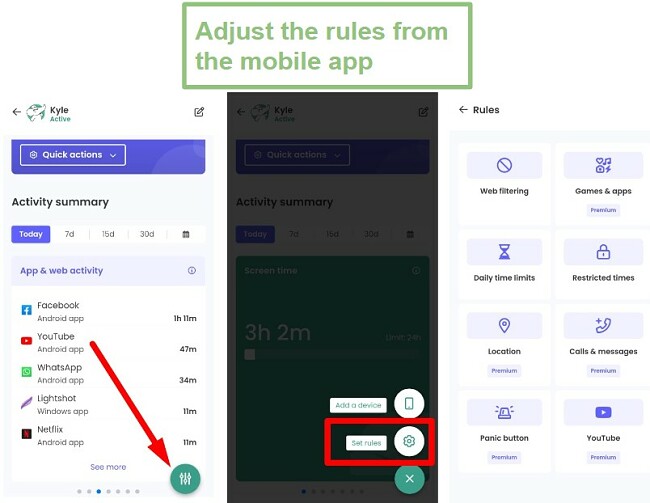
Click any of the icons to open set the rules, and it will be applied to the child’s device within a few seconds.
I was initially surprised that I couldn’t find the live location feature. Then, I remembered that the feature is called Family Locator, meaning it tracks all profiles, not just a specific child. I went back to the main menu, where I found the Family Locator icon. I opened it, and I could see my son’s live location and his location history, going back 30 days. This feature is only available on the mobile app.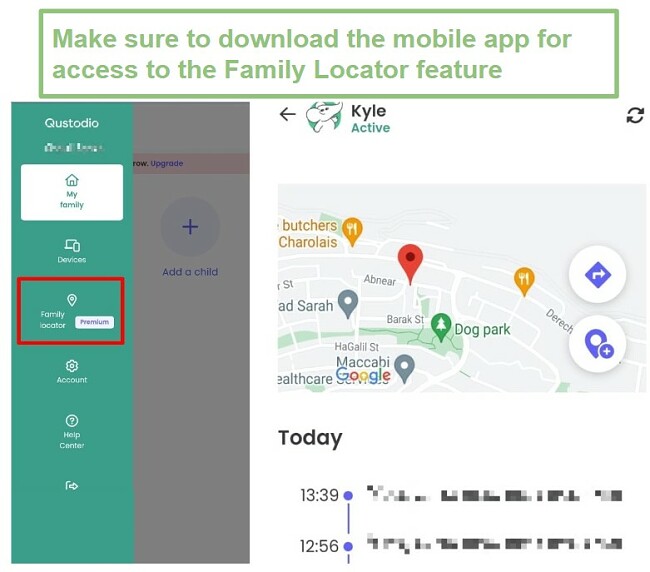
Managing Qustodio From the Browser
I found the browser-based dashboard very easy to manage, and I even prefer it over the mobile app. This is largely due to the larger screen, which allows me to view the entire Activity Summary in one glance, as opposed to having to scroll through the different sections.
Other than the screen size, the two dashboards are very similar. I can pause the internet by clicking on the Quick Actions button. The disappointing part of this feature is that I can’t pick a specific device, and so it paused my son’s phone and computer.
On the left side is a menu bar with options for the Dashboard, Timeline, and Rules.
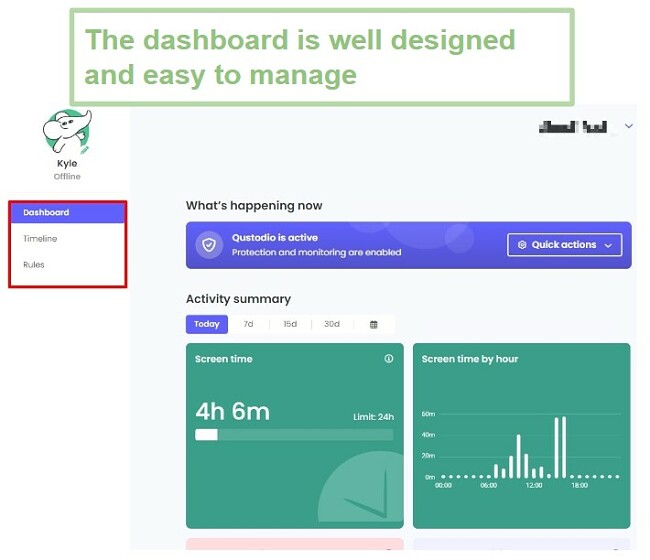
The dashboard is the default homepage. I was able to view my son’s Activity Summary and use the Quick Action button.
The Timeline shows a breakdown of everything my son has done on his phone and computer. It has a filter, so I was able to find the information I needed quickly.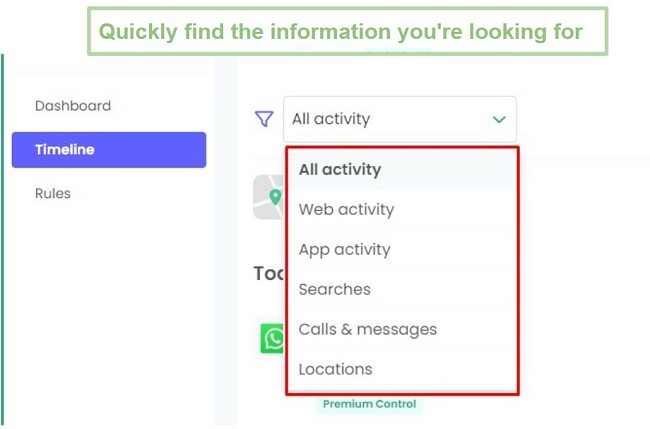
The Rules section is where I can set screen time rules, adjust the web filter, block apps, block phone numbers, and set up geofences.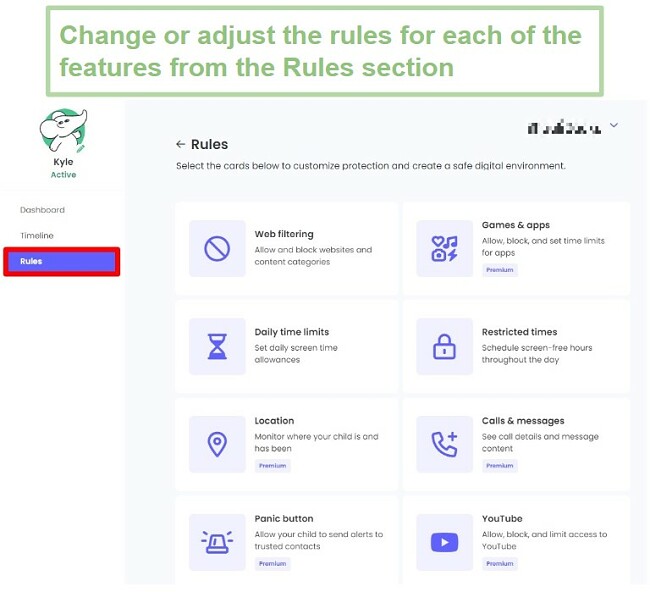
The Qustodio browser dashboard is compatible with Chrome, Firefox, Edge, and Safari.
Uninstallation Protection
Qustodio has two important features that I found helpful in ensuring my kids don’t uninstall the app. The uninstallation protection ensures that kids’ apps cannot be removed or disabled without my consent. Anytime my son opens the Qustodio Kids app, he is prompted to enter my Qustodio username and password. As long as he doesn’t have my credentials, he can’t make changes to the rules or uninstall the app.
By enabling device admin for the Qustodio app, my son can’t uninstall the app by holding down the app icon and pressing the uninstall option. The app icon will disappear for a second and quickly reappear. The only way to delete it is by logging in and disabling the app or deactivating the device admin. Qustodio has a feature to block the phone settings, which prevents the child from deactivating the device admin and uninstalling the app.
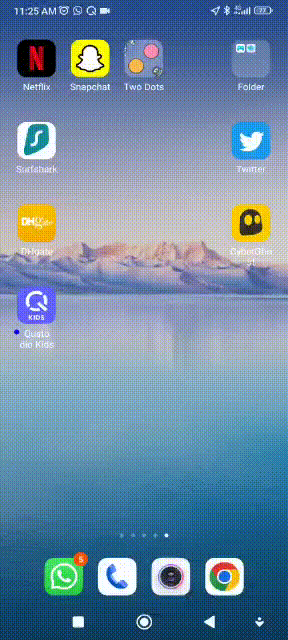
The second feature is called Hide Qustodio, which enables parents to conceal the app on Windows and macOS devices. This option redirects children to Google’s search page when they attempt to access a blocked site instead of displaying Qustodio’s web page. Additionally, it removes the Qustodio icon from the tray and notification bar and logs the child out of the device if the parent sets a screen time limit.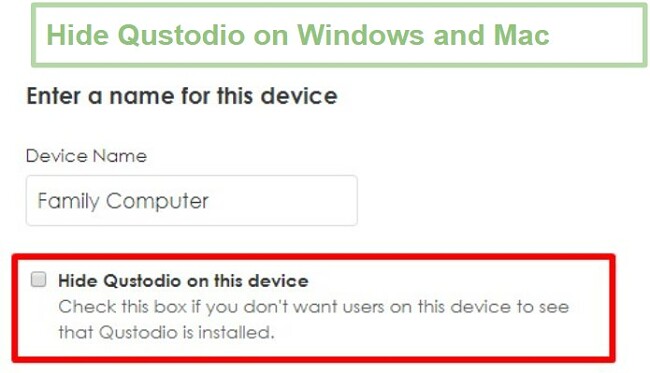
However, it’s worth noting that this feature doesn’t completely hide the app from the child, as they can still find it on their device. Therefore, it’s recommended that parents have an open discussion with their children about using parental control apps instead of relying solely on this feature.
Support
When I buy a subscription, I expect to get quality customer service and technical support. Thanks to a recent upgrade in its policy, Qustodio met my expectations. They added a Care Plus option that is included with the Medium and Large plans and can be added to the Small plan for a nominal fee. With Care Plus you can:
- Schedule a technical support phone call
- Early access to new features
- Remote assistance for the best technical support
- Periodic check-ins to ensure that everything is working properly and answer any questions you might have
I signed up for Care Plus and scheduled a phone call to talk about the uninstallation protection. A service rep called me at the prearranged time, and patiently explained to me how to make sure the settings were correct. He went through the different methods kids try and told me how to block them, such as locking my son’s phone settings, so he couldn’t deactivate the device admin and uninstall the app.
If you’re looking for instant answers, there is an extensive FAQ section. It is divided into different categories to make it easy to find the answers you need.
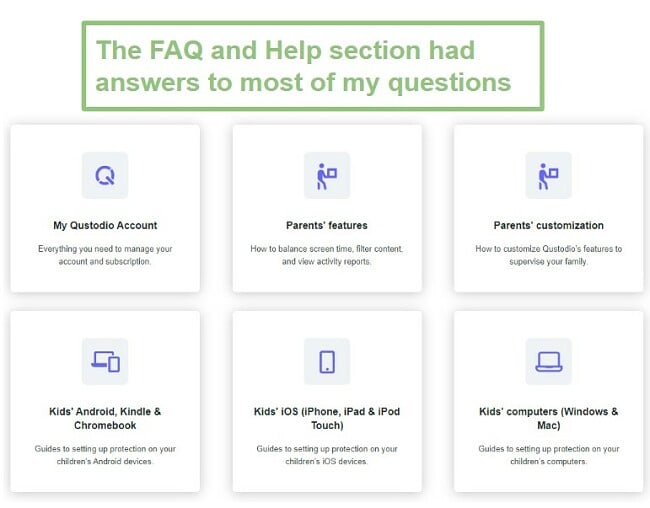
The final option is to send an email or ticket to the customer support staff. Officially, it says that responses will be sent within 1 -2 business days, but I wanted to check this out for myself. I sent a couple of questions at different times throughout the day. Getting answers quickly is important, especially since Qustodio doesn’t have a live chat. I was pleasantly surprised that I received answers to each question within 24 hours.
Is Qustodio The Best Parental Control App in 2024?
I have tested over 30 of the leading parental control apps for computers and mobile devices, and Qustodio has stood out above them all. That’s not to say that no other app has better features or that there’s no room for improvement, but when considering the overall feature set, ease of use, and value for money, Qustodio proved to be the best.
The comprehensive filter has 29 categories, and it can’t be bypassed with techniques that work on other parental control apps, such as a VPN or incognito mode. The collection of screen time tools gave me the ability to limit when my kids can be on the phone or computer, how much time they could spend every day, and how long they can use a specific app. The location tracking is very accurate, and I enjoy getting real-time alerts when my son enters and leaves the geofence area.
Not only is Qustodio compatible with all the major platforms, but it works better than most on iOS devices. There’s even a nifty workaround so the Calls and Messages feature works by syncing the data to a Mac. I like the improvements that I’ve seen with the Panic button, so my son can quickly send out a help message to his trusted contact.
However, there are some areas of improvement. In addition to YouTube Monitoring, it would be helpful if Qustodio monitored other social media networks. Also, making the Restriction Times more flexible, instead of only working in one-hour time blocks, would be a welcome change. Lastly, allowing my son to request more screen time or approve a website that was blocked directly from the interface would make it more convenient.
Even without these improvements, Qustodio is a powerful parental control app, and my son hasn’t found a way past the uninstallation protection. It’s incredibly easy to use and even has a good, although limited, free plan.
Overall, I’m confident in saying that Qustodio is the best parental control app in 2024. You don’t have to take my word for it – Qustodio is one of the few parental control apps I’ve seen with a free 30-day trial, and it doesn’t require a credit card when you sign up. This will allow you to test it on your kids 100% risk-free.
FAQs on Qustodio Parental Control App
Is Qustodio free?
Is Qustodio safe?
Qustodio also takes great care to protect your child’s data. Any information that is stored on their secure servers is separated from any identifiable user information. This means that even if the server is hacked, there’s no way to connect the information with a specific child.
Can Qustodio be bypassed?
Can Qustodio block YouTube?
Can I set a daily time limit on Qustodio?
What devices can Qustodio monitor?
Can I read messages that are sent and received on my kids’ devices?
Can my child uninstall Qustodio?
While I can’t say that it’s impossible for a child to uninstall Qustodio, it would be very difficult to do, and the parent will receive an alert right away. There are several uninstallation protection features that are enabled during installation, such as:
- Requiring a username and password to disable or remove the app
- Device admin permissions that block any attempt to uninstall the app
- Locking device settings to prevent Qustodio from monitoring the device
- Hide the app, which is an option on Windows and Macs
Pricing
Qustodio has three subscription plans: Free, Basic, and Complete. Not only do these plans differ in terms of what features are included, but in the number of protected devices as well. The free plan works on one device at a time, the Basic plan can monitor up to 5 devices simultaneously, while the Complete plan works for unlimited devices.
Qustodio’s Free Plan
When you register for Qustodio’s free plan, you’ll start with a 30-day free trial of the Complete subscription with no credit card details required. After the trial ends, you are automatically downgraded to the free plan. This plan includes the web filter, screen time monitoring, daily time limits, and setting restricted time periods.
Qustodio Basic
The Basic plan, which can monitor up to 5 devices at a time, has all the features of the free plan, plus the ability to block games and apps, 30-day activity reports, a panic button (Android only), and live location tracking.
Qustodio Complete
Upgrading to the Complete plan unlocks all the features that Qustodio offers. This includes alerts for web activity, blocked websites, and app downloads. There is also YouTube monitoring, call & message monitoring, setting up geofences, and Care Plus support.
Qustodio Free vs. Basic vs. Complete Plans
| Free Plan | Basic Plan | Complete Plan | |
| Devices | 1 | 5 | Unlimited |
| Activity Reports | Daily | 30 Days | 30 Days |
| Screen Time Monitoring | ✅ | ✅ | ✅ |
| Daily Screen Limits | ✅ | ✅ | ✅ |
| Usage Calendar | ✅ | ✅ | ✅ |
| Web Filter | ✅ | ✅ | ✅ |
| Games and Apps | ❌ | ✅ | ✅ |
| Alerts for Blocked Websites, Web Activity, & App Downloads |
❌ | ❌ | ✅ |
| Family Locator | ❌ | ✅ | ✅ |
| Geofence | ❌ | ❌ | ✅ |
| YouTube Monitoring | ❌ | ❌ | ✅ |
| Panic (SOS) Button | ❌ | ✅ | ✅ |
| Care Plus | ❌ | ❌ | ✅ |
While the price may seem a bit high at first glance, especially if you need the Complete Plan, we’re talking about protecting our kids. Between my peace of mind and the kids knowing their limitations on the phones and tablets, it’s easily the best money I’ve spent this year.
Before you commit to one of the subscription plans, you can try Qustodio risk free with a 30-day free trial. I liked that I didn’t need to enter my credit card information to activate the free trial.
Bottom Line
After using Qustodio for 30 days, I can confidently say that it is one of the best Parental Control apps I’ve ever used. Getting started was very easy, and once I set up the rules, the app worked instantly and synced all the data back to the parental dashboard.
I was able to see exactly what my kids are doing online and help create healthy habits for screen time and web browsing. The Location tracking and SOS helped keep my mind at ease when I was away on business, or my kids were out with friends. I never had to worry about where they were going, or if they were in any danger.
Overall, I recommend Qustodio to anyone interested in keeping the kids safe online. It’s absolutely worth it for the price. But before committing to a subscription, you can try all its premium features for yourself at no-risk with the 30-day free trial – no credit card is required!




